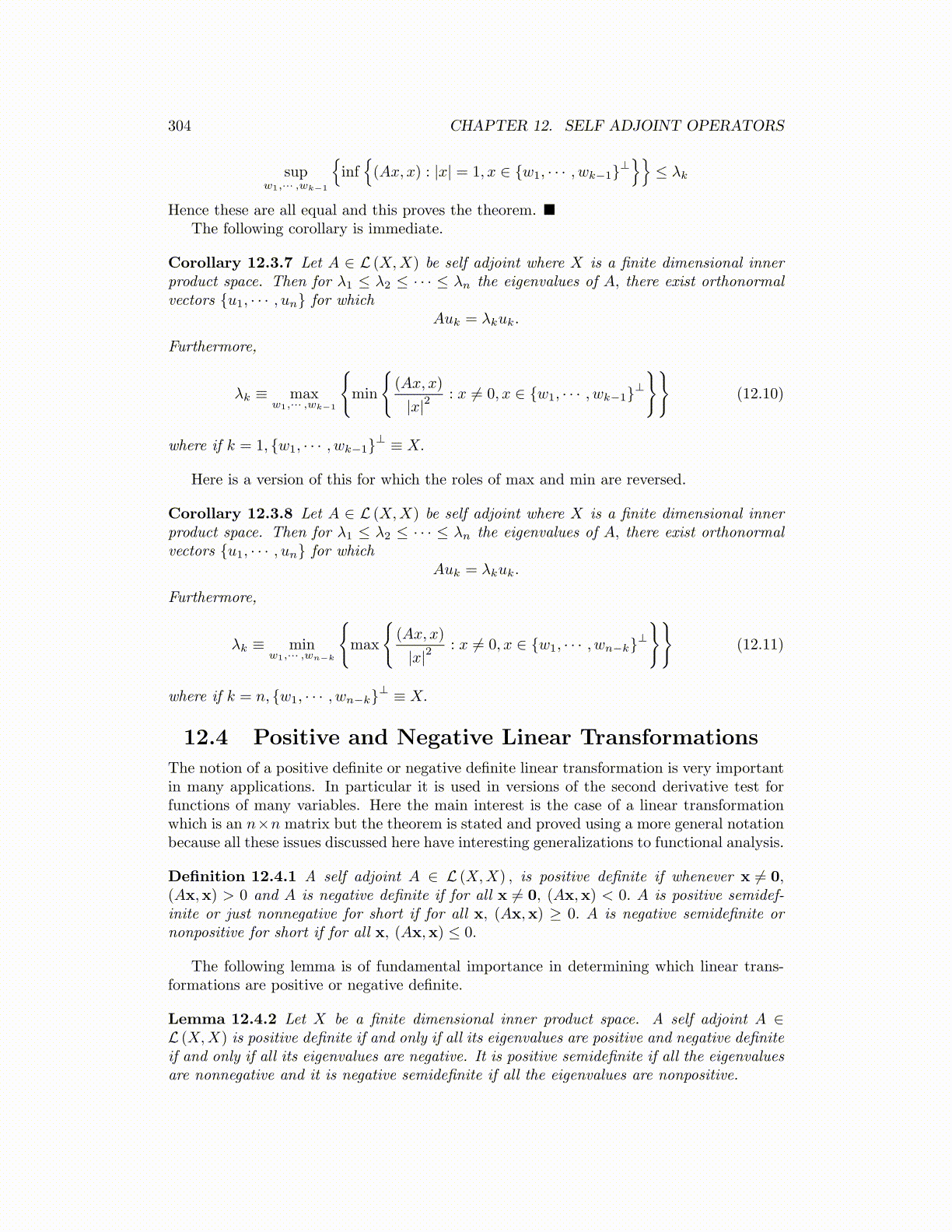
304 CHAPTER 12. SELF ADJOINT OPERATORS
supw1,··· ,wk−1
{inf{(Ax, x) : |x| = 1, x ∈ {w1, · · · , wk−1}⊥
}}≤ λk
Hence these are all equal and this proves the theorem. ■The following corollary is immediate.
Corollary 12.3.7 Let A ∈ L (X,X) be self adjoint where X is a finite dimensional innerproduct space. Then for λ1 ≤ λ2 ≤ · · · ≤ λn the eigenvalues of A, there exist orthonormalvectors {u1, · · · , un} for which
Auk = λkuk.
Furthermore,
λk ≡ maxw1,··· ,wk−1
{min
{(Ax, x)
|x|2: x ̸= 0, x ∈ {w1, · · · , wk−1}⊥
}}(12.10)
where if k = 1, {w1, · · · , wk−1}⊥ ≡ X.
Here is a version of this for which the roles of max and min are reversed.
Corollary 12.3.8 Let A ∈ L (X,X) be self adjoint where X is a finite dimensional innerproduct space. Then for λ1 ≤ λ2 ≤ · · · ≤ λn the eigenvalues of A, there exist orthonormalvectors {u1, · · · , un} for which
Auk = λkuk.
Furthermore,
λk ≡ minw1,··· ,wn−k
{max
{(Ax, x)
|x|2: x ̸= 0, x ∈ {w1, · · · , wn−k}⊥
}}(12.11)
where if k = n, {w1, · · · , wn−k}⊥ ≡ X.
12.4 Positive and Negative Linear Transformations
The notion of a positive definite or negative definite linear transformation is very importantin many applications. In particular it is used in versions of the second derivative test forfunctions of many variables. Here the main interest is the case of a linear transformationwhich is an n×n matrix but the theorem is stated and proved using a more general notationbecause all these issues discussed here have interesting generalizations to functional analysis.
Definition 12.4.1 A self adjoint A ∈ L (X,X) , is positive definite if whenever x ̸= 0,(Ax,x) > 0 and A is negative definite if for all x ̸= 0, (Ax,x) < 0. A is positive semidef-inite or just nonnegative for short if for all x, (Ax,x) ≥ 0. A is negative semidefinite ornonpositive for short if for all x, (Ax,x) ≤ 0.
The following lemma is of fundamental importance in determining which linear trans-formations are positive or negative definite.
Lemma 12.4.2 Let X be a finite dimensional inner product space. A self adjoint A ∈L (X,X) is positive definite if and only if all its eigenvalues are positive and negative definiteif and only if all its eigenvalues are negative. It is positive semidefinite if all the eigenvaluesare nonnegative and it is negative semidefinite if all the eigenvalues are nonpositive.